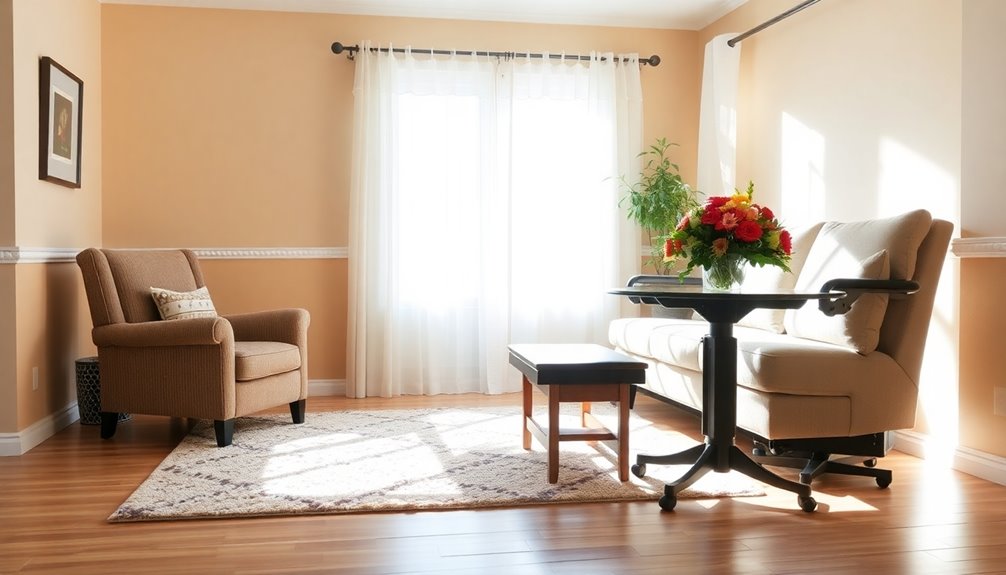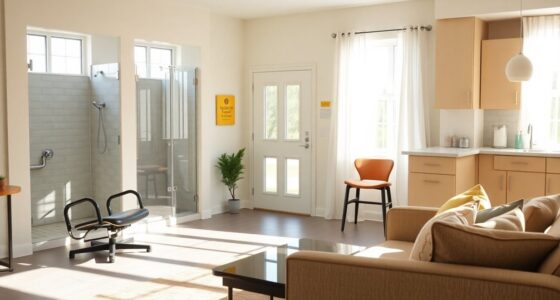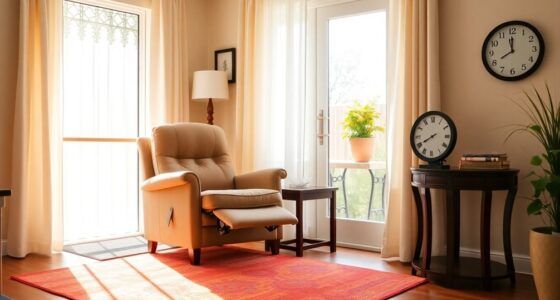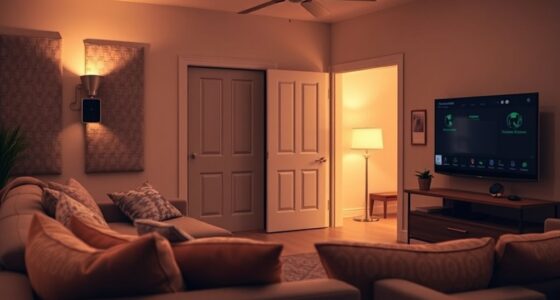Upgrading senior homes for better accessibility doesn't have to cost a fortune! Start by decluttering to create clear pathways and install grab bars in key areas like bathrooms. Replace round doorknobs with lever handles for easier use, and incorporate adaptive lighting with motion sensors. Using visual contrasts helps with navigation, and relocating outlets enhances accessibility. There are many budget-friendly options available to improve safety and comfort, so keep exploring for more great ideas!
Key Takeaways
- Install lever handles on doors for easier access, reducing strain on seniors with arthritis.
- Add grab bars in bathrooms and showers to enhance safety and promote independence.
- Incorporate motion-sensor lights to improve visibility and reduce fall risks in key areas.
- Use bold colors and high-contrast signage to assist seniors in navigating their living spaces.
- Declutter pathways and replace throw rugs with nonslip area rugs to minimize tripping hazards.
Declutter for Clear Pathways

When you declutter your home, you not only create clear pathways but also enhance safety for yourself or your loved ones.
By removing unnecessary items, you minimize tripping hazards that can lead to falls, especially for seniors.
Focus on high-traffic areas like hallways and entryways to guarantee smooth movement, particularly for those using mobility aids like wheelchairs or walkers.
Clearing furniture can greatly benefit maneuverability, providing ample space for easy navigation.
Plus, keeping surfaces organized reduces stress and promotes a serene atmosphere, crucial for overall well-being.
Regularly decluttering is essential for maintaining a safe living environment, allowing everyone to enjoy their home without the worry of obstacles.
Additionally, a well-organized space contributes to quality of life by fostering independence and comfort for seniors.
Start today and see the difference it makes!
Install Grab Bars in Key Areas
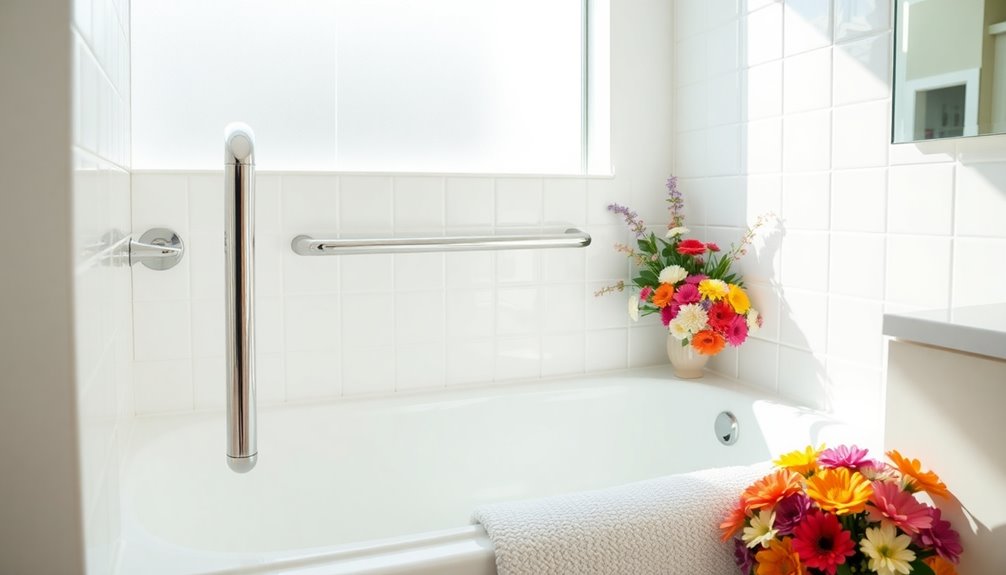
Installing grab bars in key areas like bathrooms and showers can greatly enhance safety for seniors.
You'll want to strategically place them where support is most needed, ensuring easy access and stability.
Plus, with various materials and designs available, you can choose options that complement your home's style while prioritizing functionality.
Strategic Placement Benefits
To enhance safety and mobility in senior homes, strategically placing grab bars in key areas can make a significant difference. Installing grab bars in bathrooms, next to beds, and in hallways not only reduces the risk of falls but also promotes independence. Here's a quick overview of where to install grab bars for ideal safety and convenience:
| Area | Benefit | Recommended Height |
|---|---|---|
| Bathroom | Support during showering | 33 – 36 inches |
| Bedroom | Safe movement at night | 33 – 36 inches |
| Hallway/Stairs | Additional support while moving | 33 – 36 inches |
Material and Design Choices
Choosing the right materials and designs for grab bars not only enhances safety but also complements the aesthetic of your home.
You'll want to take into account several factors to guarantee your home modifications are both functional and stylish. Here are some tips:
- Opt for durable materials like stainless steel or reinforced plastic.
- Install grab bars at a height of 33 to 36 inches for ideal usability.
- Choose finishes that match your decor, like chrome or brushed nickel.
- Confirm proper blocking behind the wall for secure installation.
- Keep your budget in mind, as the average cost ranges from $100 to $250.
Replace Round Doorknobs With Lever Handles
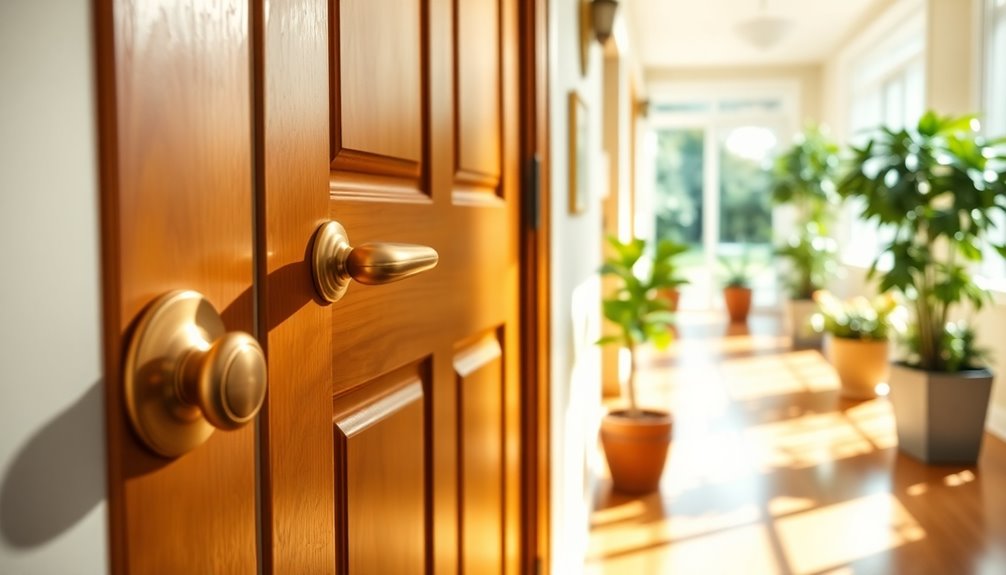
If you're looking to enhance accessibility in your home, consider replacing round doorknobs with lever handles.
They're not only easier to grip and operate, especially for those with limited hand strength, but they also come in a variety of stylish designs.
Plus, this cost-effective upgrade can transform your space without breaking the bank.
Easier Grip and Operation
Switching from round doorknobs to lever handles can transform the way seniors navigate their homes.
Lever handles provide an easier grip and require less effort to operate, making doors more accessible for those with limited hand strength or arthritis.
You'll find that:
- They can be operated with your entire hand or forearm.
- Installation is budget-friendly and often DIY-friendly.
- Lever handles boost overall home accessibility.
- They come in various styles and finishes to match your décor.
- This simple change promotes greater independence and ease of movement.
Embracing lever handles not only enhances functionality but also supports a more comfortable living environment for seniors, ensuring they can move freely and confidently throughout their homes.
Stylish and Functional Design
Lever handles not only improve accessibility but also add a touch of style to your home. Swapping out round doorknobs for lever handles is a simple home improvement that enhances functionality. These handles require just a light push or pull, making it easier for seniors and those with limited dexterity to navigate their space. Plus, with various stylish designs available, you won't have to compromise on aesthetics. Installing lever handles on all doors promotes ease of access throughout your home, ensuring safety and comfort. Additionally, implementing innovative solutions like this can significantly enhance the quality of life for the elderly, as financial considerations for home modifications can also lead to long-term savings. Effective ventilation can further improve the overall environment, making spaces more comfortable and safer.
| Benefit | Description | Cost |
|---|---|---|
| Easy Operation | Requires minimal effort to open | $10 – $30 |
| Stylish Designs | Available in various appealing styles | Varies |
| Enhanced Safety | Reduces strain for those with arthritis | Installation |
| Universal Accessibility | Suitable for all interior and exterior doors |
Cost-Effective Home Upgrade
Replacing round doorknobs with lever handles can transform your home into a more accessible space for seniors and those with limited hand strength. This simple home modification reduces the effort required to open doors, making navigation easier.
Lever handles allow for a push or pull motion, which can be operated using the forearm, wrist, or elbow, minimizing strain on arthritic hands. Plus, they come in various styles, keeping your home aesthetically pleasing.
- Budget-friendly pricing: $10 to $30 per handle
- Quick DIY installation
- Increased home accessibility
- Enhanced independence for seniors
- Stylish options available
Incorporate Adaptive Lighting
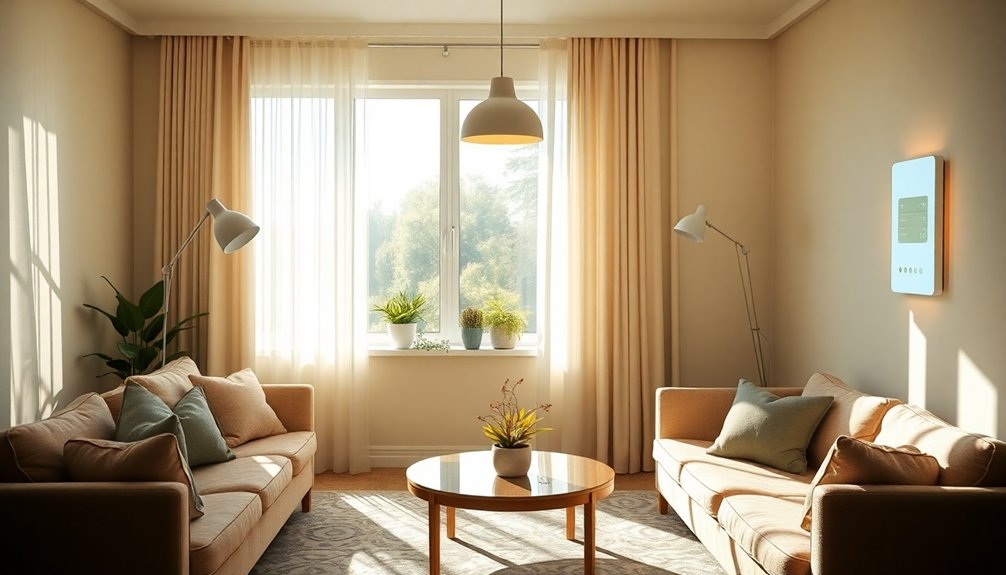
When enhancing accessibility in senior homes, incorporating adaptive lighting can make a significant difference in safety and comfort.
Installing motion-sensor lights in key areas like hallways and bathrooms improves visibility at night, reducing fall risks. Studies show that emotional stability can be influenced by environmental factors, including lighting. Additionally, ensuring good indoor air quality is vital for overall health and can be supported by the right lighting choices.
Consider adding dimmer switches, allowing seniors to customize light levels to their needs and preferences.
Switching to energy-efficient LED lights offers bright illumination while minimizing the need for frequent bulb changes, which benefits those with mobility challenges.
Guarantee light switches are easily accessible, ideally placed lower than 48 inches from the floor, to enhance usability.
Finally, using contrasting light switch covers helps individuals with low vision quickly locate and operate lights, promoting independence and safety in their living space. Additionally, ensuring proper airflow around the unit can improve the overall living conditions by enhancing indoor air quality.
Use Visual Contrasts for Navigation

Using bold colors can make a big difference in helping seniors navigate their homes safely. Clear pathway markings and high-contrast signage not only enhance visibility but also improve awareness of surroundings. Additionally, effective reduction of allergens can create a healthier living environment for seniors, further supporting their well-being. Incorporating eco-friendly practices in home modifications can also contribute to a sustainable and healthier living space for seniors. Regular cleaning of air purifiers can significantly enhance indoor air quality, ensuring a safer atmosphere for senior residents.
Bold Colors for Awareness
Bold colors and high-contrast patterns can transform the way seniors navigate their homes, making it safer and more intuitive.
By using bold colors, you can greatly enhance accessibility for those with low vision. Different colors help distinguish areas and objects, reducing the risk of accidents and falls.
Here are some ideas to reflect on:
- Use bright colors for door frames to mark entrances.
- Paint stairs in contrasting shades to highlight steps.
- Incorporate colorful furniture to improve visibility.
- Utilize large, bold signage for room identification.
- Add vibrant decor to enhance spatial awareness.
These enhancements not only add aesthetic appeal but also function as effective visual cues, empowering seniors to move confidently in their living spaces.
Clear Pathway Markings
Clear pathway markings can make a world of difference in a senior's home. By utilizing color contrasts between floors, walls, and furniture, you can greatly aid those with low vision in maneuvering safely and effectively.
Implementing visual markers, like tape or stickers, on the edges of stairs and doorways enhances awareness of potential hazards, reducing the risk of tripping. Creating distinct color boundaries on pathways helps guide seniors through their homes, making shifts between rooms intuitive. Furthermore, emotional regulation can be positively influenced by a well-organized environment, as it promotes a sense of safety and stability for seniors. Additionally, incorporating high-quality protein sources in their diets can support overall health, further encouraging mobility and independence.
Using contrasting colors in essential areas, such as bathroom fixtures or kitchen countertops, improves usability. With these budget-friendly enhancements, you'll promote better visibility and orientation, ensuring a safer living environment for seniors. Furthermore, these adjustments can greatly contribute to emotional resilience, helping seniors feel more confident and secure in their surroundings.
High-Contrast Signage Placement
While thoughtful signage placement can transform navigation for seniors, high-contrast signage is crucial for enhancing visibility and comprehension. By using contrasting colors, you make it easier for those with low vision to find their way around.
Clear signage with bold fonts guarantees that important areas are easy to identify, while visual symbols can help clarify meaning for those facing cognitive challenges.
Here are some tips for effective high-contrast signage:
- Use bold, large fonts for readability.
- Place signs at eye level for easy viewing.
- Incorporate reflective materials for nighttime visibility.
- Pair text with visual symbols for added clarity.
- Position signs near key areas like doorways or staircases.
These enhancements will greatly improve navigation in senior homes! Additionally, user control over data privacy is essential when implementing technology that aids in navigation and communication for seniors.
Modify Flooring for Safety
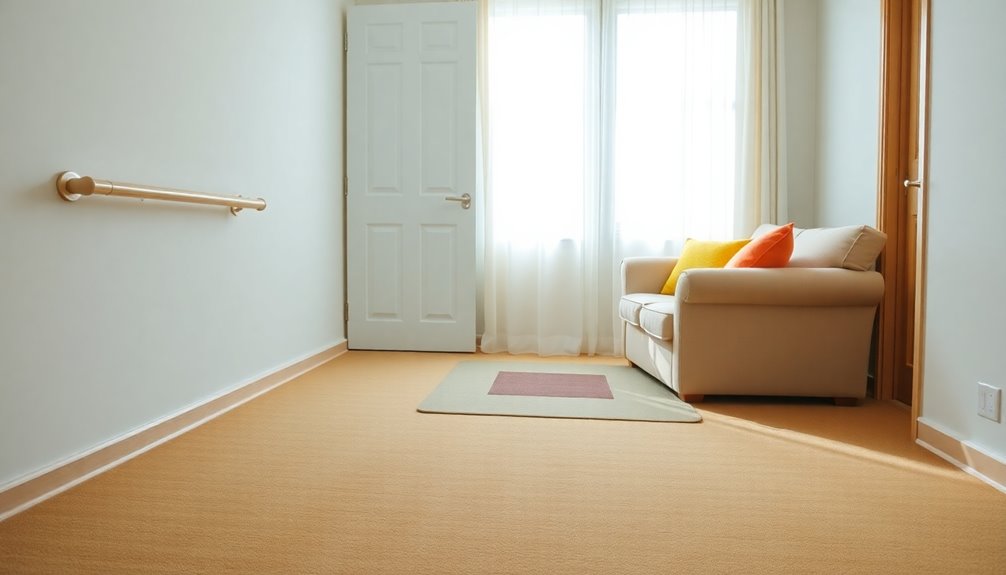
Making flooring modifications can greatly enhance safety in senior homes.
Start by replacing thick carpets with low-pile options or hardwood-style flooring to minimize trip hazards and improve mobility for seniors using mobility devices. Incorporating natural materials like bamboo or reclaimed wood can also provide a stylish yet safe flooring choice.
In wet areas like bathrooms, install textured, nonslip flooring to reduce slip risks during daily routines.
Avoid throw rugs that can cause trips; instead, use area rugs with rubber backing or secure them with non-slip pads.
Consider laminate flooring for its affordability and durability, offering a smooth surface that's easier to navigate.
Finally, guarantee all flooring changes, such as door thresholds, are low-profile to create seamless movement between rooms, further enhancing safety and preventing falls.
Additionally, these enhancements can be complemented by implementing energy-efficient systems, which can further improve the overall comfort and safety of the home environment.
These simple home modifications can make a significant difference.
Relocate Outlets and Switches
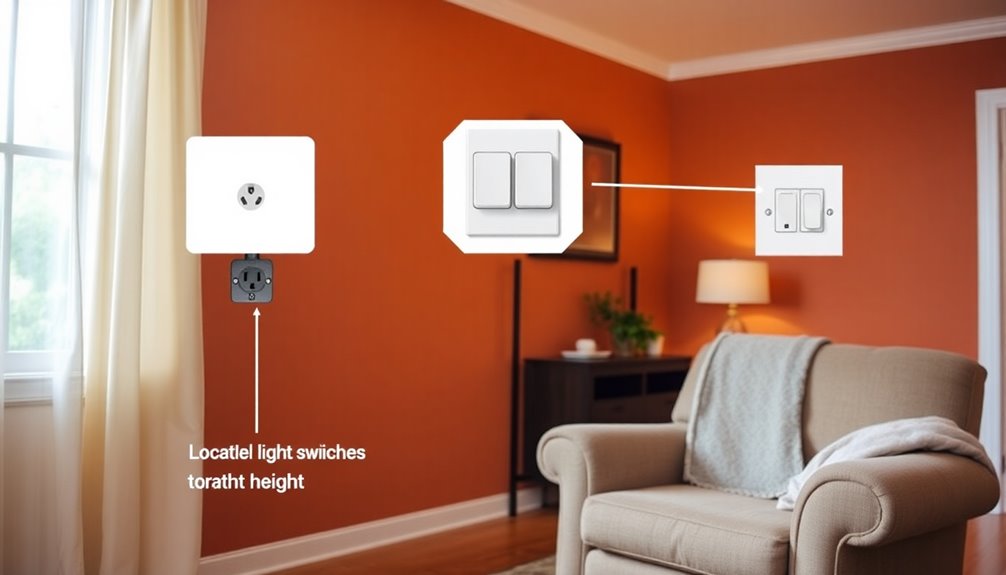
Relocating outlets and switches can greatly improve accessibility in senior homes. By making these adjustments, you enhance accessibility for seniors and individuals using mobility aids.
Consider the following tips:
- Place outlets at a height of 18 inches for easy access.
- Lower light switches to below 48 inches for convenience.
- Position outlets on the sides of kitchen cabinets to avoid bending.
- Verify outlets are reachable from the bed for operating lamps or chargers.
- Hire a licensed electrician to guarantee safety and compliance with regulations.
These modifications not only create a safer environment but also empower seniors to live more independently.
With the right changes, you can make daily tasks much more manageable and enjoyable.
Enhance Bathroom Accessibility
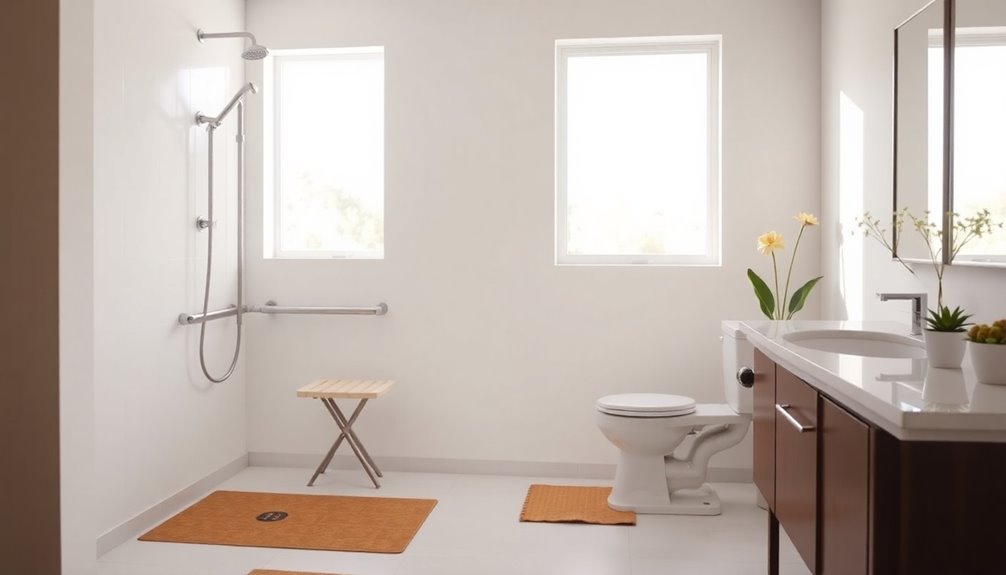
Enhancing bathroom accessibility is essential for ensuring safety and independence for seniors. Start by installing grab bars near the toilet and within the shower or bathtub. These provide stability and support, greatly reducing the risk of slips and falls.
Consider upgrading to a zero-threshold shower, which eliminates barriers, allowing for easy access without assistance. To further enhance safety, use non-slip mats or textured flooring in wet areas.
A raised toilet seat can also make sitting down and standing up easier, especially for those with mobility challenges. Finally, incorporating a handheld showerhead will provide convenience, enabling easier washing while seated and improving overall bathing safety.
These simple upgrades can make a world of difference in daily routines.
Optimize Kitchen Usability
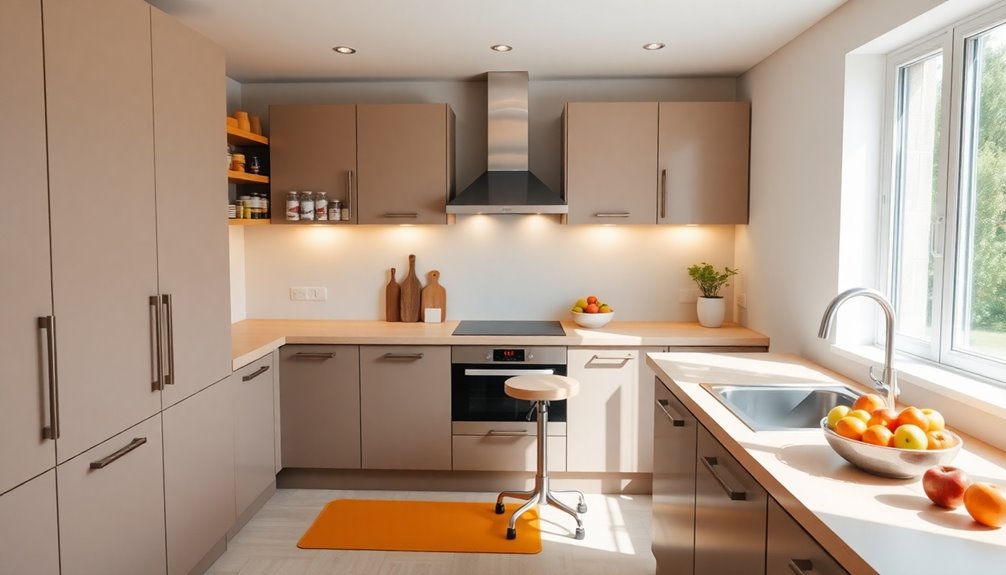
As you endeavor to create a senior-friendly kitchen, optimizing usability can greatly improve daily routines and safety.
By making a few simple changes, you can transform your space into an accessible home that meets the needs of seniors.
Consider these enhancements:
- Install lower shelves in cabinets for easy access to frequently used items.
- Replace traditional knobs with lever handles on cabinets and faucets for easier grip.
- Use adjustable countertops to accommodate both seated and standing users.
- Add non-slip mats and textured flooring to prevent slips and falls.
- Position microwaves and ovens at waist height to avoid bending and reaching.
These modifications not only enhance safety but also promote independence in the kitchen, making daily tasks more manageable.
Seek Community Resources for Support
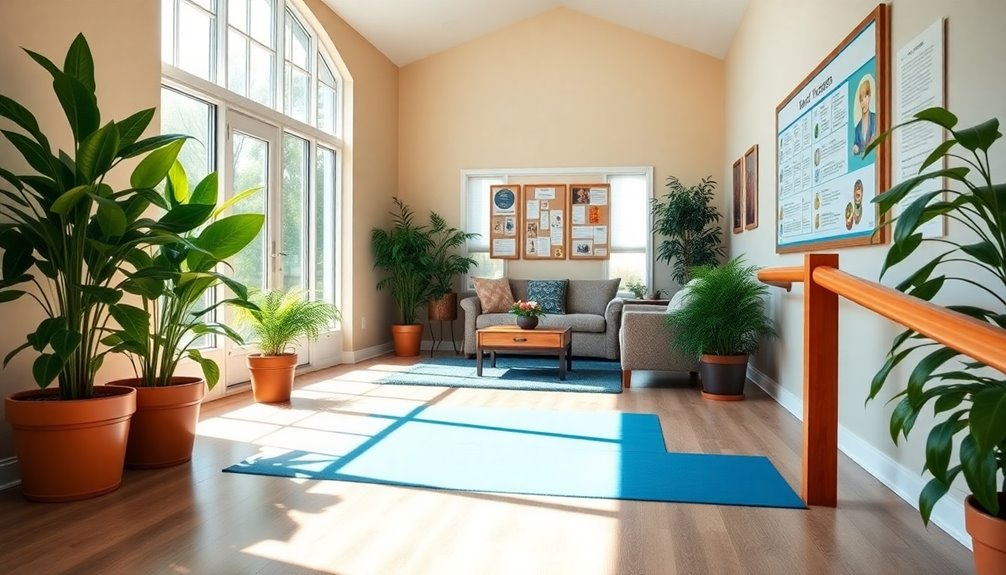
When seeking ways to improve accessibility in senior homes, tapping into community resources can make a significant difference.
Many local non-profits offer free or low-cost home modification services designed specifically for seniors. Government programs like Home and Community-Based Services (HCBS) waivers can provide funding for essential accessibility upgrades.
Community centers often host workshops that teach seniors and caregivers DIY skills for affordable home modifications. Additionally, local volunteer groups may connect you with skilled tradespeople who can assist with necessary adjustments at little or no cost.
Don't underestimate the power of social media; online platforms can link you with community members enthusiastic to help, share resources, or provide materials for your accessibility projects.
Frequently Asked Questions
How Can Homes Be Modified to Support Older Adults?
You can modify homes to support older adults by making simple yet effective changes.
Install lever-style door handles and faucets to reduce joint strain. Use non-slip flooring in bathrooms to minimize slip risks. Add grab bars in essential areas for stability and support.
Elevate electrical outlets and lower light switches for easier access.
Finally, consider smart home technology, like voice-activated systems, to enhance independence and make daily tasks more manageable.
What Are Examples of Home Modifications?
When considering home modifications, think about installing grab bars in bathrooms and hallways for added stability.
You can replace round doorknobs with lever handles to make doors easier to open.
Implementing zero-step entries and ramps can greatly improve access for wheelchair users.
Adjusting countertop and cabinet heights guarantees essential items are within reach.
Finally, using non-slip flooring and removing throw rugs enhances safety, creating a more secure living space for everyone.
How to Modify the Home Environment for People With Disabilities?
To modify the home environment for people with disabilities, start by installing lever-style door handles and faucets to ease access.
Incorporate grab bars in bathrooms and hallways for added support. Replace round doorknobs with lever handles to simplify door operation.
Use non-slip mats and raised toilet seats to enhance bathroom safety.
Finally, declutter high-traffic areas to create clear pathways, improving overall mobility and accessibility throughout the home.
What Is a Home Modification Aid?
Have you ever wondered how to make your home more accessible without breaking the bank?
A home modification aid is financial assistance designed to help you cover the costs of essential accessibility improvements. These aids come from various sources like government programs and non-profits, and eligibility often depends on your income, age, and specific needs.
They can fund installations like grab bars and ramps, markedly easing the financial burden of necessary modifications.
Conclusion
Upgrading senior homes doesn't have to break the bank. By decluttering pathways, installing grab bars, replacing knobs with levers, and enhancing lighting, you create a safer, more comfortable environment. Use visual contrasts for navigation, relocate outlets for convenience, enhance bathroom accessibility, and optimize kitchen usability. Finally, don't forget to seek community resources for support. These budget-friendly enhancements not only improve safety but also promote independence, ensuring seniors can enjoy their homes with confidence and ease.
